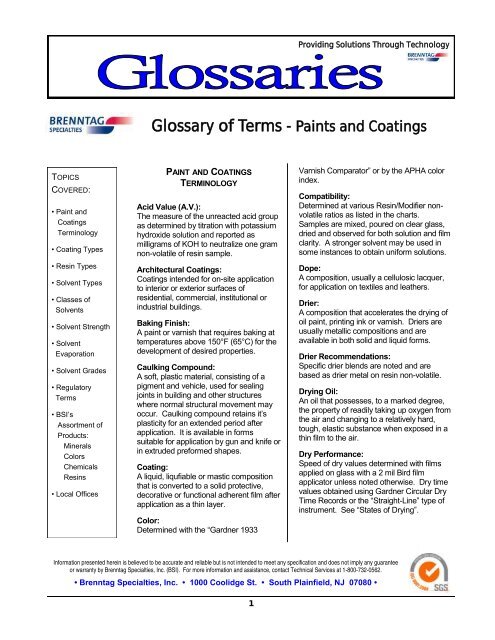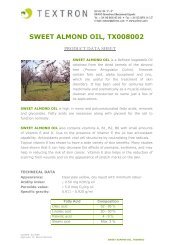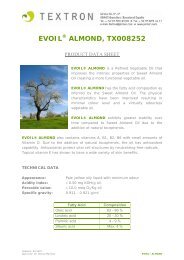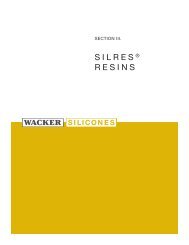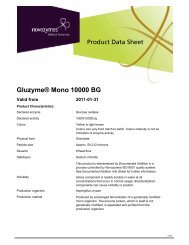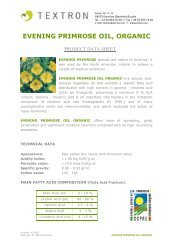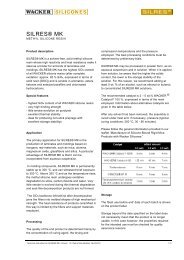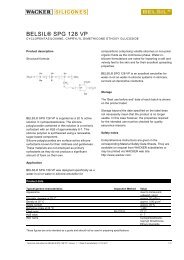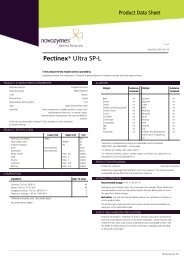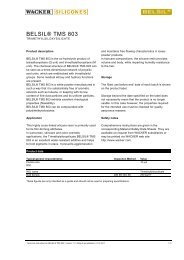Glossary of Terms - Paints and Coatings - Brenntag Specialties, Inc.
Glossary of Terms - Paints and Coatings - Brenntag Specialties, Inc.
Glossary of Terms - Paints and Coatings - Brenntag Specialties, Inc.
You also want an ePaper? Increase the reach of your titles
YUMPU automatically turns print PDFs into web optimized ePapers that Google loves.
TOPICS<br />
COVERED:<br />
• Paint <strong>and</strong><br />
<strong>Coatings</strong><br />
Terminology<br />
• Coating Types<br />
• Resin Types<br />
• Solvent Types<br />
• Classes <strong>of</strong><br />
Solvents<br />
• Solvent Strength<br />
• Solvent<br />
Evaporation<br />
• Solvent Grades<br />
• Regulatory<br />
<strong>Terms</strong><br />
• BSI’s<br />
Assortment <strong>of</strong><br />
Products:<br />
Minerals<br />
Colors<br />
Chemicals<br />
Resins<br />
• Local Offices<br />
<strong>Glossary</strong> <strong>of</strong> <strong>Terms</strong> - <strong>Paints</strong> <strong>and</strong> <strong>Coatings</strong><br />
PAINT AND COATINGS<br />
TERMINOLOGY<br />
Acid Value (A.V.):<br />
The measure <strong>of</strong> the unreacted acid group<br />
as determined by titration with potassium<br />
hydroxide solution <strong>and</strong> reported as<br />
milligrams <strong>of</strong> KOH to neutralize one gram<br />
non-volatile <strong>of</strong> resin sample.<br />
Architectural <strong>Coatings</strong>:<br />
<strong>Coatings</strong> intended for on-site application<br />
to interior or exterior surfaces <strong>of</strong><br />
residential, commercial, institutional or<br />
industrial buildings.<br />
Baking Finish:<br />
A paint or varnish that requires baking at<br />
temperatures above 150°F (65°C) for the<br />
development <strong>of</strong> desired properties.<br />
Caulking Compound:<br />
A s<strong>of</strong>t, plastic material, consisting <strong>of</strong> a<br />
pigment <strong>and</strong> vehicle, used for sealing<br />
joints in building <strong>and</strong> other structures<br />
where normal structural movement may<br />
occur. Caulking compound retains it’s<br />
plasticity for an extended period after<br />
application. It is available in forms<br />
suitable for application by gun <strong>and</strong> knife or<br />
in extruded preformed shapes.<br />
Coating:<br />
A liquid, liqufiable or mastic composition<br />
that is converted to a solid protective,<br />
decorative or functional adherent film after<br />
application as a thin layer.<br />
Color:<br />
Determined with the “Gardner 1933<br />
1<br />
Providing Solutions Through Technology<br />
Varnish Comparator” or by the APHA color<br />
index.<br />
Compatibility:<br />
Determined at various Resin/Modifier nonvolatile<br />
ratios as listed in the charts.<br />
Samples are mixed, poured on clear glass,<br />
dried <strong>and</strong> observed for both solution <strong>and</strong> film<br />
clarity. A stronger solvent may be used in<br />
some instances to obtain uniform solutions.<br />
Dope:<br />
A composition, usually a cellulosic lacquer,<br />
for application on textiles <strong>and</strong> leathers.<br />
Drier:<br />
A composition that accelerates the drying <strong>of</strong><br />
oil paint, printing ink or varnish. Driers are<br />
usually metallic compositions <strong>and</strong> are<br />
available in both solid <strong>and</strong> liquid forms.<br />
Drier Recommendations:<br />
Specific drier blends are noted <strong>and</strong> are<br />
based as drier metal on resin non-volatile.<br />
Drying Oil:<br />
An oil that possesses, to a marked degree,<br />
the property <strong>of</strong> readily taking up oxygen from<br />
the air <strong>and</strong> changing to a relatively hard,<br />
tough, elastic substance when exposed in a<br />
thin film to the air.<br />
Dry Performance:<br />
Speed <strong>of</strong> dry values determined with films<br />
applied on glass with a 2 mil Bird film<br />
applicator unless noted otherwise. Dry time<br />
values obtained using Gardner Circular Dry<br />
Time Records or the “Straight-Line” type <strong>of</strong><br />
instrument. See “States <strong>of</strong> Drying”.<br />
Information presented herein is believed to be accurate <strong>and</strong> reliable but is not intended to meet any specification <strong>and</strong> does not imply any guarantee<br />
or warranty by <strong>Brenntag</strong> <strong>Specialties</strong>, <strong>Inc</strong>. (BSI). For more information <strong>and</strong> assistance, contact Technical Services at 1-800-732-0562.<br />
• <strong>Brenntag</strong> <strong>Specialties</strong>, <strong>Inc</strong>. • 1000 Coolidge St. • South Plainfield, NJ 07080 •
Enamel:<br />
A paint that is characterized by an ability to form an<br />
especially smooth film.<br />
Ester Gum:<br />
A resin made from rosin or rosin acids <strong>and</strong> a polyhydric<br />
alcohol, such as glycerine or pentaerythritol.<br />
Filler:<br />
A pigmented composition for filing the pores or<br />
irregularities in a surface preparatory to application <strong>of</strong><br />
other finishes.<br />
Fire Retardant Coating:<br />
A coating that will do one or more <strong>of</strong> the following.<br />
*Reduce the flame spread on the substrate<br />
over which the coating is applied, some-<br />
times at the sacrifice <strong>of</strong> the coating (see in<br />
tumescent coating).<br />
*Resist ignition <strong>of</strong> the substrate when ex-<br />
posed to high temperature.<br />
*Insulate the substrate to which the coating<br />
is applied <strong>and</strong> thereby prolong the time<br />
required to reach it’s ignition, melting or<br />
structural-weakening temperature.<br />
Flash Point:<br />
Tested on either a “Setaflash Tester” or the “Tag<br />
Closed Cup Flash Tester” (TCC). If not indicated, the<br />
values are determined with the Setaflash unit.<br />
Glaze:<br />
A very thin coating <strong>of</strong> a paint product usually a semitransparent<br />
coating tinted with Van Dyke brown, burnt<br />
sienna or a similar pigment, applied on a previously<br />
painted surface to produce a decorative effect.<br />
Glazing Compound:<br />
A dough like material consisting <strong>of</strong> pigment <strong>and</strong><br />
vehicle, used for sealing window glass in frames. It<br />
differs from putty in that it retains its plasticity for an<br />
extended period.<br />
Hydroxy Equivalent Weight (HEW):<br />
The amount <strong>of</strong> resin (by weight non-volatile) that will<br />
crosslink or react with one equivalent weight <strong>of</strong><br />
crosslinker such as isocyanate or melamine<br />
formaldehyde resin.<br />
Intumescent Coating:<br />
A fire-retardant coating, that when heated, forms a<br />
foam produced by nonflammable gases, such as<br />
carbon dioxide <strong>and</strong> ammonia. This results in a thick,<br />
highly insulating layer <strong>of</strong> carbon (about fifty times as<br />
thick as the original coating) that serves to protect the<br />
coated substrate from the fire.<br />
Glossaries<br />
MINERALS COLORS CHEMICALS ADDITIVES RESINS EQUIPMENT<br />
2<br />
Japan:<br />
A varnish yielding a hard, glossy, dark colored film.<br />
Japans are usually dried by baking at relatively high<br />
temperatures.<br />
Lacquer:<br />
A coating composition that is based on synthetic<br />
thermoplastic film-forming material dissolved in organic<br />
solvent that dries primarily by solvent evaporation.<br />
Typical lacquers include those based on nitrocellulose,<br />
other cellulose derivatives, vinyl resins, acrylic resins,<br />
etc.<br />
Lake:<br />
A special type <strong>of</strong> pigment consisting essentially <strong>of</strong> an<br />
organic soluble coloring matter combined more or less<br />
definitely with an organic base or carrier. It is<br />
characterized generally by a bright color <strong>and</strong> a more or<br />
less pronounced translucency when made into an oil<br />
paint.<br />
Mildewstat:<br />
A chemical agent that inhibits the growth <strong>of</strong> mildew.<br />
Naval Stores:<br />
Chemically reactive oils, resins, tars <strong>and</strong> pitches<br />
derived from the oleoresin contained in, exuded by, or<br />
extracted from trees chiefly <strong>of</strong> the pine species or from<br />
the wood <strong>of</strong> such trees.<br />
Nondrying Oil:<br />
An oil that does not <strong>of</strong> itself possess to a perceptible<br />
degree, the power to take up oxygen from the air <strong>and</strong><br />
lose it’s liquid characteristics.<br />
Nonvolatile Vehicle:<br />
The liquid portion <strong>of</strong> a paint excepting it’s volatile<br />
thinner <strong>and</strong> water<br />
Oil <strong>of</strong> Turpentine:<br />
The pharmaceutical name for spirits <strong>of</strong> turpentine<br />
which conforms to the requirements <strong>of</strong> the National<br />
Formulary.<br />
Paint:<br />
A classification sometimes employed to distinguish<br />
pigmented drying oil coatings (“paints”) from synthetic<br />
enamels <strong>and</strong> lacquers.<br />
Percent Non-Volatile (%NV):<br />
Non-volatile or solids based as percentage <strong>of</strong> total<br />
solution weight. Several different methods <strong>of</strong><br />
determination are employed depending upon resin type<br />
<strong>and</strong> relative reactivity. Process solids are generally<br />
determined on a hotplate at 198° C <strong>and</strong> 10 to 20<br />
minutes dwell time.
Pigment:<br />
The fine solid particles used in the preparation <strong>of</strong> paint<br />
or printing ink <strong>and</strong> substantially insoluble in the vehicle.<br />
Asphaltic materials are not pigments except when they<br />
contain substances substantially insoluble in the<br />
vehicle in which they are used.<br />
Pine Oil:<br />
A colorless to amber colored volatile oil with<br />
characteristics pinaceous odor, consisting principally <strong>of</strong><br />
isomeric tertiary <strong>and</strong> secondary cyclic terpene alcohols,<br />
with variable quantities <strong>of</strong> terpene hydrocarbons,<br />
ethers, keytones, phenols <strong>and</strong> phenolic ethers, the<br />
amount <strong>and</strong> character <strong>of</strong> which depend on the source<br />
<strong>and</strong> method <strong>of</strong> manufacture. The four commercial<br />
kinds <strong>of</strong> pine oil are:<br />
*Steam distilled pine oil - obtained from crude oleo-<br />
resinous extract <strong>of</strong> pinewood during the process <strong>of</strong><br />
related steam-distilled wood naval stores.<br />
*Destructively distilled pine oil - obtained from the<br />
lighter distillate from the destructive distillation<br />
(carbonization) <strong>of</strong> pine wood oil.<br />
*Synthetic pine oil - obtained by chemical hydration<br />
<strong>of</strong> terpene hydrocarbons to form the terpene alcohols,or<br />
by dehydration <strong>of</strong> terpene hydrate.<br />
*Sulfate pine oil - A high boiling fraction obtained in<br />
the refining <strong>and</strong> fractional distillation <strong>of</strong> the con-<br />
densed vapors released during the digestion <strong>of</strong><br />
wood by the sulfate process.<br />
Pine Tar Oil:<br />
The oil obtained by condensing the vapors from the<br />
retorts in which resinous pine wood is destructively<br />
distilled (carbonized).<br />
Platicizer:<br />
A very low volatility substance added to paint, varnish<br />
or lacquer to impart flexibility.<br />
Primer:<br />
The first <strong>of</strong> two or more coats <strong>of</strong> paint, varnish or<br />
lacquer system.<br />
Printing Ink:<br />
A colored or pigmented liquid or paste composition that<br />
dries to a solid film after application as a thin layer by<br />
printing machinery.<br />
Putty:<br />
A dough-like material consisting <strong>of</strong> pigment <strong>and</strong><br />
vehicle, used for sealing glass in frames <strong>and</strong> for filling<br />
imperfections in wood or metal surfaces.<br />
Resin, Natural:<br />
A solid organic substance, originated in the secretion <strong>of</strong><br />
certain plants or insects, which is thermoplastic,<br />
Glossaries<br />
3<br />
flammable, nonconductive <strong>of</strong> electricity; breaks with a<br />
conchoidal fracture (when hard) <strong>and</strong> dissolves in<br />
certain specific organic solvents, but not water.<br />
Resin, Synthetic:<br />
A synthetic substance physically similar to natural<br />
resin. <strong>Inc</strong>ludes acrylic, alkyd, ester gum, maleic,<br />
melamine, penta, phenolic, styrene, urea <strong>and</strong> vinyl<br />
resin types to name a few.<br />
Rosin:<br />
A specific kind <strong>of</strong> natural resin obtained as a vitreous<br />
water-insoluble material from pine oleoresin by removal<br />
<strong>of</strong> the volatile oils, or from tall oil by the removal <strong>of</strong> the<br />
fatty acid components there<strong>of</strong>. It consists primarily <strong>of</strong><br />
tricyclic monocarboxylic acids. The three commercial<br />
classifications <strong>of</strong> rosins are.<br />
*Gum Rosin - obtained from oleoresin collected from<br />
living trees.<br />
*Wood Rosin - obtained from the oleoresin<br />
contained in dead wood such as stumps <strong>and</strong> knots.<br />
*Tall Oil Rosin - obtained from tall oil.<br />
Sealer:<br />
A liquid composition to prevent excessive absorption <strong>of</strong><br />
finish coats into porous surfaces: also a composition to<br />
prevent bleeding (see also “Size”).<br />
Semidrying Oil:<br />
An oil that possesses the characteristics <strong>of</strong> a drying oil<br />
but to a lesser degree. There is no definite line <strong>of</strong><br />
demarcation between drying <strong>and</strong> semidrying oils.<br />
Size:<br />
Usually a liquid composition to prevent excessive<br />
absorption <strong>of</strong> all paints into plaster, old wall paint <strong>and</strong><br />
similar porous surfaces. Also a liquid composition used<br />
as a first coat on metal to improve adhesion <strong>of</strong><br />
succeeding coats (latter usage is limited to the metal<br />
decorating industry). The term “sealer <strong>and</strong> size” are<br />
almost synonymous, but usage has established certain<br />
differences. A sealer is ordinarily a thin varnish or<br />
clear lacquer <strong>and</strong> is usually applied to wood or metal<br />
surfaces. Ordinary painter’s size is a thin solution <strong>of</strong><br />
glue, starch or other water-soluble substances <strong>and</strong> is<br />
usually applied on plater surfaces, but size used in<br />
metal decorating is a thin varnish.<br />
Solvent Tolerance:<br />
Milliliters <strong>of</strong> test solvent necessary to cause turbidity<br />
when added to 10 grams <strong>of</strong> resin solution. See “Test<br />
Solvent MST”.<br />
Stain:<br />
A penetrating composition that changes the color <strong>of</strong> a<br />
surface, usually transparent <strong>and</strong> leaving practically no<br />
surface film.<br />
MINERALS COLORS CHEMICALS ADDITIVES RESINS EQUIPMENT
States <strong>of</strong> Drying:<br />
*Dust Free - Film is considered dust free when the<br />
finger, without pressure, may be lightly run over the<br />
surface without sticking. The surface may be<br />
slightly sticky, but no pronounced marks will be left<br />
by the finger.<br />
*Tack-Free - Film is considered tack-free when the<br />
finger, with slight pressure will not leave a mark.<br />
The surface shall not be sticky.<br />
*Dry-through - Film cannot be distorted or removed<br />
when the thumb is placed on the horizontal film <strong>and</strong><br />
rotated 90° with maximum body weight. No distor-<br />
tion, loosening, wrinkling or detachment <strong>of</strong> the film<br />
should be evident.<br />
*Dry-hard or To full hardness - The film is difficult<br />
to remove with a fingernail <strong>and</strong> has good resistance<br />
to the edge <strong>of</strong> a knife.<br />
Surfacer:<br />
A pigmented composition for filling minor irregularities<br />
to obtain a smooth uniform surface preparatory to<br />
applying finish coats: usually applied over a primer <strong>and</strong><br />
s<strong>and</strong>ed for smoothness.<br />
Tall Oil:<br />
A generic name for a number <strong>of</strong> products obtained<br />
from the manufacture <strong>of</strong> wood pulp by the alkali<br />
(sulfate) process or more popularly known as the Kraft<br />
Process. To provide some distinctions between the<br />
various products, designations are <strong>of</strong>ten applied in<br />
accordance with the process or composition, some <strong>of</strong><br />
which are crude tall oil, acid refined tall oil, distilled tall<br />
oil, tall oil fatty acids or tall oil rosin.<br />
Tall Oil Fatty Acids:<br />
The class <strong>of</strong> products generally containing 90 percent<br />
or more fatty acids obtained by fractionation <strong>of</strong> crude<br />
tall oil. The fatty acids are a mixture <strong>of</strong> C18 fatty acids,<br />
especially oleic <strong>and</strong> linoleic acids, with lesser amounts<br />
<strong>of</strong> saturated <strong>and</strong> other unsaturated fatty acids.<br />
Tall Oil Rosin:<br />
Separated from the tall oil heads, fatty acids, <strong>and</strong> tall oil<br />
pitch by fractional distillation <strong>of</strong> tall oil. Such rosin shall<br />
have the characteristic form, appearance <strong>and</strong> other<br />
physical <strong>and</strong> chemical properties normal for other kinds<br />
<strong>of</strong> rosin.<br />
Temporary Coating:<br />
A coating designed to protect or decorate a substrate<br />
for a limited time that can be readily removed either by<br />
mechanical or chemical means.<br />
Terpenes:<br />
A class <strong>of</strong> unsaturated organic compounds having the<br />
empirical formula C10H16 occurring in most essential<br />
Glossaries<br />
4<br />
oils <strong>and</strong> oleoresinous plants. Structurally, the important<br />
terpenes <strong>and</strong> their derivatives are classified as<br />
monocyclic (dipentene), bicyclic (pinene) <strong>and</strong> acyclic<br />
(mycrene).<br />
Test Solvent, MST:<br />
Special st<strong>and</strong>ardized solvent blend for used in Mineral<br />
Spirits Tolerance Determination. Consists <strong>of</strong><br />
approximately, by weight.<br />
*80 - 85% Exempt mineral spirits.<br />
*15 - 20% Solvesso 100.<br />
Turpentine, Spirits <strong>of</strong>:<br />
The volatile oil consisting primarily <strong>of</strong> a number <strong>of</strong><br />
terpene hydrocarbons <strong>of</strong> the general formula C10H16.<br />
Four kinds <strong>of</strong> turpentine are now recognized.<br />
*Gum turpentine or gum spirits - obtained by distill-<br />
ing the crude exuded gum or oleoresin collected<br />
from living pine trees.<br />
*Steam distilled wood turpentine - obtained from<br />
the oleoresin within the wood <strong>of</strong> pine stumps or<br />
cuttings, either by direct steaming <strong>of</strong> the<br />
mechanically disintegrated wood or after solvent<br />
extraction <strong>of</strong> the oleoresin from the wood.<br />
*Sulfate wood turpentine - recovered during the<br />
conversion <strong>of</strong> wood to paper pulp by the sulfate<br />
process. Refined turpentine is the name for a<br />
commercially available grade that is produced by<br />
removing primarily sulfur compounds from sulfate<br />
wood turpentine.<br />
*Destructively distilled wood turpentine - obtained<br />
by fractionation <strong>of</strong> certain oils recovered by<br />
condensing the vapors formed during the destructive<br />
distillation <strong>of</strong> pine wood.<br />
Turpentines, Various:<br />
*Canada Turpentine - Same as Canada balsam, the<br />
oleoresin obtained from Canadian silver fir trees.<br />
*Sulfite Turpentine - This term is not in good usage,<br />
because the volatile oil recovered in the conversion<br />
<strong>of</strong> wood to pulp by the sulfite process consists<br />
chiefly <strong>of</strong> cymene (C10H14) rather than pinene <strong>and</strong><br />
other terpenes.<br />
*Venice Turpentine - Same as larch turpentine, the<br />
oleoresin <strong>of</strong> the European larch tree. The term is<br />
also now used widely to describe the clear yellow<br />
liquid portion <strong>of</strong> pine oleoresin, or a synthetic<br />
product <strong>of</strong> similar composition made by dissolving<br />
rosin in a terpene solvent.<br />
Thinner:<br />
The portion <strong>of</strong> a paint, varnish, lacquer or printing ink or<br />
related product that volatizes during the drying process.<br />
Tint:<br />
A color produced by the mixture <strong>of</strong> white pigment or<br />
MINERALS COLORS CHEMICALS ADDITIVES RESINS EQUIPMENT
paint in predominating amount with a colored pigment<br />
or paint, not white. The tint <strong>of</strong> a color is, therefore,<br />
much lighter <strong>and</strong> less saturated than the color itself.<br />
Toner:<br />
An organic pigment that does not contain inorganic<br />
pigment or inorganic carrying base.<br />
Varnish:<br />
A liquid composition that is converted to a transparent<br />
or translucent solid film after application as a thin layer.<br />
Some <strong>of</strong> the most common types are:<br />
*Bituminous Varnish - A dark-colored varnish<br />
containing bituminous ingredients. The varnish may<br />
be either <strong>of</strong> the oil or spirit type.<br />
*Oil Varnish - A varnish that contains resin <strong>and</strong><br />
drying oil as the basic film-forming ingredients <strong>and</strong><br />
is converted to a solid film primarily by chemical<br />
reaction.<br />
*Spar Varnish - A varnish for exterior surfaces. The<br />
name originated from it’s use on spars <strong>of</strong> ships.<br />
*Spirit Varnish - A varnish that is converted to a<br />
solid film primarily by solvent evaporation.<br />
Vehicle:<br />
The liquid portion <strong>of</strong> a paint or printing ink. Anything<br />
that is dissolved in the liquid portion <strong>of</strong> a paint or<br />
printing ink is a part <strong>of</strong> the vehicle.<br />
Viscosity, Virgin:<br />
As supplied measured at 77° F via Gardner Holdt<br />
viscosity st<strong>and</strong>ards unless otherwise noted.<br />
Viscosity, cPa.s:<br />
Viscosity as measured in centiPascal / seconds with<br />
the Rotary Viscometer”, Brookfield or equivalent.<br />
Viscosity, Reduced:<br />
Resin reduced to specified % n.v. as noted <strong>and</strong> thinned<br />
with the solvent specified. Measured at 77° F with the<br />
Gardner Holdt viscosity st<strong>and</strong>ards unless otherwise<br />
noted.<br />
Weight Per Gallon, (WPG):<br />
The weight by volume <strong>of</strong> virgin resin solution<br />
determined with a weight-per-US gallon measuring cup<br />
at 77° F.<br />
Zinc-Rich Primer:<br />
A primer for ferrous metals, incorporating zinc dust at a<br />
concentration sufficient to make the dried film<br />
electrically conductive thus providing cathodic<br />
protection to the ferrous substrate.<br />
Glossaries<br />
5<br />
COATING TYPES<br />
Air Dry Coating:<br />
A coating formulation which dries solely by solvent<br />
evaporation without the application <strong>of</strong> heat.<br />
Architectural Coating:<br />
<strong>Coatings</strong> intended for on-site application to interior or<br />
exterior surfaces <strong>of</strong> residential, commercial, institutional<br />
or industrial buildings. These finishes are applied at<br />
ambient temperatures <strong>and</strong> dry without being heated.<br />
Also called trade sale coatings.<br />
Baking Finish:<br />
A coating which requires heating at temperatures<br />
above 150° F for curing <strong>and</strong> the development <strong>of</strong><br />
desired properties.<br />
Coating:<br />
A generic term for paints, lacquers, enamels, etc. Also<br />
a liquid composition which is converted to a solid<br />
protective, decorative or functional adherent film after<br />
application as a thin layer.<br />
Enamel:<br />
A topcoat which is characterized by it’s ability to form a<br />
smooth surface. May also be called a thermosetting or<br />
baking finish.<br />
House Paint:<br />
A coating designed for use on large exterior surfaces <strong>of</strong><br />
a building. Generally <strong>of</strong> lower gloss than the coating<br />
used on trim areas. May be either water based or oil<br />
based.<br />
Lacquer:<br />
A coating based on thermoplastic polymer dissolved in<br />
organic solvent <strong>and</strong> which dries primarily by solvent<br />
evaporation. The coating can be redissolved in it’s<br />
original solvent blend. The most common polymers<br />
used in lacquers are nitrocellulose, vinyl resins <strong>and</strong><br />
acrylic resins.<br />
Latex:<br />
A stable dispersion <strong>of</strong> a polymer in a continuous liquid<br />
medium, usually water. Prepared by emulsion<br />
polymerization.<br />
Latex Paint:<br />
A coating which uses a latex as the principal binder.<br />
Widely used for interior <strong>and</strong> exterior house paints.<br />
Contains only small amounts <strong>of</strong> solvents, usually<br />
glycols, glycol ethers <strong>and</strong> glycol ether esters.<br />
Nonaqueous Dispersion (NAD):<br />
The solvent analogue <strong>of</strong> a latex: a dispersion <strong>of</strong> a<br />
polymer in a volatile organic liquid which is not a<br />
MINERALS COLORS CHEMICALS ADDITIVES RESINS EQUIPMENT
solvent for the polymer. Low-solvency aliphatic<br />
hydrocarbons are the most commonly used solvents.<br />
Oil Paint:<br />
Paint that contains a drying oil as the sole film forming<br />
ingredient. Linseed oil is most commonly used for this<br />
purpose. Aliphatic hydrocarbons are used in small<br />
amounts as the solvent.<br />
Paint:<br />
Any pigmented liquid designed for application to a<br />
substrate in a thin layer which is converted to an<br />
opaque solid film after application. Used for protection,<br />
decoration or identification, or to serve some functional<br />
purpose such as the filling or concealing <strong>of</strong> surface<br />
irregularities, the modification <strong>of</strong> light <strong>and</strong> heat radiation<br />
characteristics, etc.<br />
Primer:<br />
First complete coat <strong>of</strong> paint applied to a surface.<br />
Designed to provide adequate adhesion to new<br />
surfaces. The type <strong>of</strong> primer varies with the surface,<br />
it’s condition, <strong>and</strong> the total painting system to be used.<br />
Shellac:<br />
Orange colored resin which is the secretion <strong>of</strong> the lac<br />
beetle found in great quantities in India <strong>and</strong> Indochina.<br />
Shellac is ordinarily dissolved in denatured ethyl<br />
alcohol.<br />
Thermoplastic Resin:<br />
Resin which remains fluid on heating <strong>and</strong> hardens<br />
when cooled. Remains soluble in the original solvent<br />
<strong>and</strong> does not become insoluble upon heating.<br />
Thermosetting Resin:<br />
Resin which polymerizes to a permanently solid<br />
infusible state upon the application <strong>of</strong> heat. Once<br />
heated, it will not dissolve in the original solvent blend.<br />
Varnish:<br />
A liquid composition which is converted to a<br />
transparent solid film after application as a thin layer.<br />
Once the film has completely dried, it will no longer<br />
dissolve in the solvent blend from which it was applied.<br />
RESIN TYPES<br />
Acrylics:<br />
Resins made from the polymerization <strong>of</strong> esters <strong>of</strong><br />
acrylic <strong>and</strong> methacrylic acids. Most acrylics require<br />
strong solvents, although some may be formulated<br />
using aromatic hydrocarbons without oxygenated<br />
solvents.<br />
Glossaries<br />
6<br />
Alkyds:<br />
Synthetic resins formed by the condensation <strong>of</strong><br />
polyhydric alcohols <strong>and</strong> polybasic acids. They may be<br />
regarded as complex esters. The most common<br />
ingredients are glycerine <strong>and</strong> phthalic anhydride.<br />
Many alkyds also are made with monocarboxylic acids<br />
derived from vegetable oils such as soybean oil <strong>and</strong><br />
linseed oil. Solvent requirements vary, ranging from<br />
strong aromatic hydrocarbons for alkyds which contain<br />
small amounts <strong>of</strong> oil modifiers to low solvency aliphatic<br />
hydrocarbons, suitable for alkyd resins which have<br />
high concentrations <strong>of</strong> oil modifiers.<br />
Chain Stopped Alkyd:<br />
A very fast drying alkyd that has been modified (chain<br />
terminated) with a mono-functional material that<br />
imparts lacquer type dry speed with fast hardness<br />
development.<br />
Copolymer Alkyd:<br />
A drying oil alkyd modified with styrene, vinyl toluene,<br />
reactive silicone or acrylic monomer.<br />
Epoxy Resins:<br />
Resins which contain epoxy groups (also known as<br />
oxirane rings). Most commonly made from<br />
epichlorohydrin <strong>and</strong> bisphenol A. Epoxy resins may be<br />
liquid or solid, depending on their molecular weight.<br />
They use mixtures <strong>of</strong> alcohol, keytones <strong>and</strong><br />
hydrocarbon solvents.<br />
Nitrocellulose:<br />
A synthetic cellulosic resin prepared by treating<br />
cellulose with a mixture <strong>of</strong> nitric sulfuric acids. Widely<br />
used as a resin for lacquers <strong>and</strong> as a film-forming<br />
material for flexographic <strong>and</strong> gravure inks. Primary<br />
resinous material used in fine furniture finishes.<br />
Nitrocellulose requires strong solvents. Mixtures <strong>of</strong><br />
keytones, esters <strong>and</strong> hydrocarbons are used as<br />
solvents, <strong>and</strong> alcohols are included as latent solvents.<br />
Nitrocellulose is also known by the names cellulose<br />
nitrate <strong>and</strong> pyroxylin.<br />
Oil Length:<br />
Generally refers to the oil content or phthalic anhydride<br />
content <strong>of</strong> an alkyd polymer.<br />
*Short Oil - generally contains from 40 to 50 percent<br />
phthalic anhydride.<br />
*Medium Oil - contains from 30 to 40 percent<br />
phthalic anhydride.<br />
*Long Oil - contains from 20 to 30 percent phthalic<br />
anhydride.<br />
Polyester Resins:<br />
A special type <strong>of</strong> alkyd resin, prepared from<br />
dicarboxylic acids <strong>and</strong> dihydroxy alcohols. Commonly<br />
MINERALS COLORS CHEMICALS ADDITIVES RESINS EQUIPMENT
copolymerized with styrene resin employing peroxide<br />
initiators. Widely used in fiberglass reinforced plastics<br />
in boats, chemically resistant structures <strong>and</strong><br />
transportation applications.<br />
Urethane Resins:<br />
Materials based on isocyanate monomer reacted with<br />
other materials to yield polymers containing any ratio <strong>of</strong><br />
urethane linkages, active isocyanate groups or<br />
polyisocyanate monomer. The resin may contain<br />
excess isocyanate groups available for further reaction<br />
at the time <strong>of</strong> application or may contain essentially no<br />
free isocyanate as supplied.<br />
Vinyl Resins:<br />
Resins based on vinyl chloride monomer. Most<br />
frequently copolymerized with other monomers such as<br />
vinyl acetate. Most vinyl resins require very strong<br />
solvents, such as keytones, to form useful solutions.<br />
SOLVENT TYPES<br />
Active Solvent:<br />
A solvent which by itself, will dissolve a resin.<br />
Base Solvent:<br />
The solvent blend which is used in the preparation <strong>of</strong> a<br />
coating for dissolving the resin <strong>and</strong> dispersing the<br />
pigments.<br />
Building Block:<br />
A relatively narrow boiling range hydrocarbon which<br />
may be combined with other narrow range<br />
hydrocarbons to form a multitude <strong>of</strong> blends precisely<br />
formulated to meet specific requirements. The building<br />
block approach employs cuts which are predominately<br />
aromatic or predominately aliphatic in nature. The<br />
boiling range varies from very low boiling petroleum<br />
ether type solvents to kerosene type materials.<br />
Cosolvent:<br />
A blend <strong>of</strong> two or more solvents, neither <strong>of</strong> which will<br />
dissolve the resin by itself, but which will act as a true<br />
solvent for the material when used together. Each<br />
cosolvent must evaporate at about the same rate,<br />
otherwise resin precipitation will occur as drying<br />
proceeds.<br />
Diluent:<br />
A solvent which will not dissolve the resin <strong>of</strong> interest.<br />
Normally used to dilute active solvent mixes to lower<br />
the cost <strong>of</strong> the solvent blend without sacrificing<br />
performance. Hydrocarbons are the most common<br />
diluents. Active solvent mixtures differ in their<br />
tolerance for diluents before the resin precipitates.<br />
Glossaries<br />
7<br />
More aromatic hydrocarbon will be tolerated than<br />
aliphatic hydrocarbon before resin precipitation occurs.<br />
Dissolution:<br />
The process <strong>of</strong> forming a solution, in which the resin<br />
dissolves in the solvent.<br />
EGMBE:<br />
Ethylene glycol monobutyl ether. (butyl Cellosolve®).<br />
Exempt Blend:<br />
A solvent blend that complies with Rule 66 or Rule<br />
2.62 air pollution regulations.<br />
iso-BuOAc:<br />
iso-butyl acetate.<br />
iso-BuOH:<br />
is-butyl alcohol.<br />
Latent Solvent:<br />
A solvent which is not a true solvent for the material<br />
being dissolved, but which will act as a solvent in the<br />
presence <strong>of</strong> an active solvent. Alcohols are the most<br />
common latent solvents.<br />
MAK:<br />
methyl n-amyl ketone.<br />
MPK:<br />
methyl propyl ketone.<br />
n-BuOAc:<br />
normal butyl acetate.<br />
n-BuOH:<br />
normal butyl alcohol.<br />
Solvent:<br />
A liquid, usually volatile, which is used in the<br />
manufacture <strong>of</strong> coatings to dissolve or disperse the film<br />
-forming constituents, <strong>and</strong> which evaporates during<br />
drying <strong>and</strong> does not become a part <strong>of</strong> the dried film.<br />
Solvents are used to control the viscosity <strong>and</strong> character<br />
<strong>of</strong> the finish <strong>and</strong> to regulate application properties.<br />
Thinner:<br />
A blend <strong>of</strong> solvents used to lower the viscosity <strong>of</strong> the<br />
coating prior to application. The amount <strong>of</strong> thinner<br />
used will depend upon the coating <strong>and</strong> the method <strong>of</strong><br />
application. Thinners usually contain more<br />
hydrocarbon <strong>and</strong> less active solvent than base<br />
solvents do.<br />
MINERALS COLORS CHEMICALS ADDITIVES RESINS EQUIPMENT
CLASSES OF SOLVENTS<br />
Oxygenated Solvents:<br />
General designation <strong>of</strong> those solvents which contain<br />
oxygen in addition to carbon <strong>and</strong> hydrogen in the<br />
molecular. Oxygenated Solvents or “Oxys” may be<br />
divided into several chemical types.<br />
*Ketones - A class <strong>of</strong> active, strong solvents<br />
characterized by a carbonyl group. Trade names<br />
include acetone, methyl ethyl ketone, methyl<br />
isobutyl ketone <strong>and</strong><br />
diacetone alcohol ketones.<br />
*Esters - A class <strong>of</strong> active solvents formed from<br />
organic acids <strong>and</strong> alcohols by the elimination <strong>of</strong><br />
water.<br />
*Alcohols - Latent solvents for many materials.<br />
Characterized by the presence <strong>of</strong> a Hydroxyl (-OH)<br />
group. Capable <strong>of</strong> strong hydrogen bonding. Trade<br />
names include isopropyl alcohol, n-butyl alcohol,<br />
isobutyl alcohol, secondary butyl alcohol, methyl<br />
isobutyl carbinol <strong>and</strong> 2-ethyl hexanol.<br />
*Glycol Ethers - Prepared from alcohols <strong>and</strong><br />
ethylene or propylene oxide. Glycol ethers contain<br />
both ether groups <strong>and</strong> hydroxyl groups, thereby<br />
possessing the characteristics <strong>of</strong> both. Trade<br />
names include butyl ether <strong>of</strong> ethylene glycol <strong>and</strong><br />
the butyl ether <strong>of</strong> diethylene glycol.<br />
Hydrocarbon Solvent Types:<br />
Compounds composed exclusively <strong>of</strong> hydrogen <strong>and</strong><br />
carbon atoms. There are several types <strong>of</strong> hydrocarbon<br />
compounds.<br />
*Olefins - Characterized by unsaturation. Relatively<br />
reactive, used as a raw material for manufacturing<br />
many solvents. Not used in hydrocarbon solvent<br />
directly, although traces <strong>of</strong> olefins may be found in<br />
some hydrocarbon solvents.<br />
*Paraffins - Completely saturated hydrocarbons<br />
characterized by a chain structure. Poorest<br />
solvency <strong>of</strong> the hydrocarbon solvents. Lowest odor.<br />
*Naphthenes - Completely saturated hydrocarbons<br />
characterized by ring structures. Intermediate<br />
solvency between paraffin <strong>and</strong> aromatic<br />
hydrocarbons. Intermediate odor. Also known as<br />
cycloparaffins.<br />
*Aromatics - Characterized by unsaturated, six<br />
carbon benzene ring structures. Hydrocarbon<br />
solvents which contain more that 50% aromatic<br />
compounds are designatd as aromatic hydrocarbon<br />
solvents. Strongest <strong>of</strong><br />
the hydrocarbon solvents. Strongest odor.<br />
Chlorinated Hydrocarbons:<br />
Characterized by the presence <strong>of</strong> chlorine.<br />
Glossaries<br />
8<br />
Nitroparaffins:<br />
Characterized by the presence <strong>of</strong> a nitro group.<br />
SOLVENT STRENGTH<br />
Aniline Cloud Point:<br />
A measure <strong>of</strong> solvent strength, used for aliphatic<br />
hydrocarbon solvents only. The Aniline Cloud Point is<br />
defined as the minimum temperature at which a 1/1 by<br />
volume mixture <strong>of</strong> hydrocarbon <strong>and</strong> pure aniline are<br />
miscible with each other. The Aniline Cloud Point is<br />
also known as Aniline Point <strong>and</strong> Aniline Number. The<br />
st<strong>and</strong>ard test method is ASTM D-611.<br />
Fractional Polarity:<br />
A measure <strong>of</strong> the polar character <strong>of</strong> a solvent. Values<br />
range between zero <strong>and</strong> one, the higher the value, the<br />
more polar the solvent. Hydrocarbons have very low<br />
polarity, while oxygenated solvents have higher<br />
polarity.<br />
Hydrogen Bonding Index:<br />
Measure the strength <strong>of</strong> the hydrogen bonding that<br />
occurs in a solvent. Hydrogen bonding values range<br />
from -18 to +15. Hydrocarbons display little hydrogen<br />
bonding ability, alcohols are strong hydrogen binders,<br />
<strong>and</strong> other solvents are intermediate between these two<br />
extremes. While there are different systems for<br />
measuring hydrogen bonding capability, the Shell<br />
system is based on infrared analysis <strong>of</strong> the solvent.<br />
Kauri-Butanol Value:<br />
A measure <strong>of</strong> solvent strength, used for hydrocarbon<br />
solvents only. A solution <strong>of</strong> Kauri gum in n-butyl<br />
alcohol is titrated to a specified degree <strong>of</strong> turbidity with<br />
the hydrocarbon solvent being tested. Values range<br />
from 20+ to 105. The higher values denote stronger<br />
hydrocarbon solvency. Typical aliphatic hydrocarbons<br />
have KB Values between 28 <strong>and</strong> 40, while aromatic<br />
hydrocarbons have KB Values above 70. The<br />
st<strong>and</strong>ard test method is ASTM Method D-1133<br />
Mixed Aniline Cloud Point:<br />
A measure for solvent strength, used for aromatic<br />
hydrocarbon solvents only. The same equipment is<br />
used as for the Aniline Cloud Point employed for<br />
aliphatic hydrocarbon solvents, except that the<br />
aromatic hydrocarbon solvent is diluted with an equal<br />
volume <strong>of</strong> pure n-heptane before mixing with aniline.<br />
The st<strong>and</strong>ard test method is ASTM D-611.<br />
Solubility Parameter:<br />
A measure <strong>of</strong> solvency whose major usefulness lies in<br />
predicting whether a particular solvent will dissolve a<br />
particular resin. Based on heat <strong>of</strong> vaporization <strong>of</strong> the<br />
MINERALS COLORS CHEMICALS ADDITIVES RESINS EQUIPMENT
solvent. Stronger solvents generally have higher<br />
solubility parameter values.<br />
Solvent Power:<br />
A general term denoting the ability <strong>of</strong> a solvent to<br />
dissolve resin or binder <strong>and</strong> hold it in solution. Also<br />
known as solvency.<br />
SOLVENT EVAPORATION<br />
t90:<br />
The length <strong>of</strong> time required for 90% <strong>of</strong> the weight <strong>of</strong> the<br />
solvent to evaporate at st<strong>and</strong>ard conditions. Another<br />
convenient way to compare the evaporation rates <strong>of</strong><br />
solvents. The st<strong>and</strong>ard test method is ASTM Method<br />
D-3539, the Shell Thin Film EvaporOmeter. In that test<br />
method, a measured volume <strong>of</strong> solvent is dispensed<br />
onto a piece <strong>of</strong> filter paper. The weight is recorded<br />
automatically, then the evaporation rate is calculated<br />
using a computer program.<br />
Distillation Range:<br />
The temperature range over which a mixture <strong>of</strong> liquids<br />
will distill. The range is narrow for most oxygenated<br />
solvents, because they are essentially pure chemical<br />
compounds. Hydrocarbon materials have wider<br />
distillation ranges, some quite wide. ASTM Method D-<br />
86 is used for hydrocarbon solvents, D-828 for<br />
oxygenated solvents.<br />
Flash Point:<br />
The lowest temperature at which a liquid gives <strong>of</strong>f<br />
sufficient vapor to form an ignitable mixture with air.<br />
This concentration is also known as the Lower<br />
Flammability Limit. The two most widely used test<br />
methods are Tagliabue Closed Cup (TCC), ASTM Test<br />
Method D-56, <strong>and</strong> the Setaflash tester, ASTM Test<br />
Method D-3828. Any solvent which has a flash point<br />
below 141° F is designated “Red Label” <strong>and</strong> must have<br />
a specific warning sticker attached.<br />
Relative Evaporation Rate:<br />
The evaporation rate <strong>of</strong> a solvent compared to a<br />
st<strong>and</strong>ard, usually n-butyl acetate, with the rate <strong>of</strong> nbutyl<br />
acetate set equal to 1.00. Solvents which<br />
evaporate faster than n-butyl acetate have a relative<br />
evaporation rate greater than one. Those which<br />
evaporate more slowly have a relative evaporation rate<br />
<strong>of</strong> less than one.<br />
Vapor Pressure:<br />
The pressure exerted when a liquid is in equilibrium<br />
with its own vapor. A liquid, enclosed in a given space<br />
at a given temperature, will evaporate until the<br />
Glossaries<br />
9<br />
pressure <strong>of</strong> the liquid in the gas phase is equal to the<br />
pressure <strong>of</strong> the liquid at that temperature. The vapor<br />
pressure <strong>of</strong> a solvent is a fundamental thermodynamic<br />
property controlling volatility, evaporation <strong>and</strong><br />
distillation. A solvent with a higher vapor pressure at a<br />
given temperature will evaporate faster <strong>and</strong> distill at a<br />
lower temperature.<br />
Volatility:<br />
The tendency <strong>of</strong> a substance to evaporate.<br />
SOLVENT GRADES:<br />
Electronic Grade:<br />
Electronic industry solvent specifications are concerned<br />
mostly with metals content, especially heavy metals<br />
<strong>and</strong> particulate matter content. Most solvents will meet<br />
those specifications as produced. However,<br />
contamination during shipping <strong>and</strong> h<strong>and</strong>ling can occur<br />
very easily, rendering the solvent unsuitable. Since<br />
dust is everywhere, careful filtration is needed at the<br />
point <strong>of</strong> use in the electronics plant.<br />
National Formulary (NF) Grade:<br />
St<strong>and</strong>ards for certain pharmaceuticals <strong>and</strong> reagents<br />
published by the American Pharmaceutical<br />
Association. Recognized as <strong>of</strong>ficial st<strong>and</strong>ards by the<br />
Pure Food <strong>and</strong> Drug Act <strong>of</strong> 1906. Since 1974, the<br />
National Formulary has been combined with the United<br />
States Pharmacopeia (USP).<br />
United States Pharmacopeia (USP) Grade:<br />
A legally recognized compendium <strong>of</strong> st<strong>and</strong>ards for<br />
drugs, published by The United States Pharmacopeial<br />
Convention, <strong>Inc</strong>., <strong>and</strong> revised periodically. It also<br />
includes assays <strong>and</strong> tests for the determination <strong>of</strong><br />
strength, quality <strong>and</strong> purity. The USP lists<br />
specifications for a number <strong>of</strong> solvents used in the<br />
pharmaceutical industry. Specifications covering<br />
specific gravity, distillation range, residue on<br />
evaporation <strong>and</strong> acidity are the most common. For<br />
materials for which a USP st<strong>and</strong>ard has not been<br />
established, the ACS Reagent grade is frequently<br />
specified. The American Chemical Society st<strong>and</strong>ards<br />
are published in ACS Reagent Chemicals.<br />
Urethane Grade:<br />
Urethane grade solvents are needed for use with<br />
urethane formulations. Any substance which contains<br />
active hydrocarbons capable <strong>of</strong> reacting with<br />
isocyanates will be restricted to very low levels.<br />
Specifications for urethane grade solvents typically<br />
center on very low water <strong>and</strong> alcohol contents, typically<br />
0.1% or less. Glycol ethers also contain active<br />
hydrocarbons <strong>and</strong> are not suitable for use in urethanes.<br />
MINERALS COLORS CHEMICALS ADDITIVES RESINS EQUIPMENT
Historically, esters have contained significant amounts<br />
<strong>of</strong> alcohol. More recently, alcohol free grades <strong>of</strong> esters<br />
have been produced with the designation “Urethane<br />
Grade”. The usual quality grades <strong>of</strong> hydrocarbons <strong>and</strong><br />
ketones ordinarily are suitable for urethanes, even<br />
though they may not be designated specifically as<br />
urethane grade.<br />
REGULATORY TERMS<br />
33/50 Initiative (Air Toxics Initiative):<br />
A voluntary EPA program, in which over 500<br />
companies were asked to reduce emissions <strong>of</strong><br />
seventeen compounds at a faster rate than would<br />
occur under the Air Toxics provisions <strong>of</strong> the Clean Air<br />
Act Amendments. The objective is 33% reduction by<br />
the end <strong>of</strong> 1992 compared to 1988 emission levels,<br />
<strong>and</strong> 50% by the end <strong>of</strong> 1995.<br />
Alternative Control Techniques (ACT’s):<br />
Refers to guidance to be developed by the EPA for<br />
VOC <strong>and</strong> NOx sources <strong>of</strong> 25 tons per year or more.<br />
American Conference <strong>of</strong> Government <strong>and</strong><br />
Industrial Hygienists (ACGIH):<br />
The body empowered to develop the Threshold Limit<br />
Values (TLV’s) which govern permissible worker<br />
exposure. Located in Cincinnati, OH, they publish a<br />
summary booklet <strong>of</strong> TLV’s in addition to a summary <strong>of</strong><br />
the information used to decide the TLV for a specific<br />
compound.<br />
Area Source:<br />
Any stationary source <strong>of</strong> hazardous air pollutants that<br />
is not a major source, to be regulated under a different<br />
provision <strong>of</strong> the Clean Air Act Amendments.<br />
Best Available Control Technology (BACT):<br />
Technology required on new major sources <strong>and</strong> major<br />
modifications subject to PSD requirements, which<br />
reflect the best controls in use taking into account costs<br />
<strong>and</strong> other non-air quality factors.<br />
California Air Resources Board (CARB):<br />
The air pollution control agency for the state <strong>of</strong><br />
California.<br />
Carcinogen:<br />
The Registry <strong>of</strong> Toxics Effects <strong>of</strong> Chemical Substances<br />
(RTECS), published by NIOSH, indicates whether a<br />
chemical has been fund by the United Nations<br />
International Agency for Research on Cancer (IARC)<br />
or the National Toxicology Program (NTP) to be a<br />
carcinogen or a potential carcinogen. IARC has<br />
published approximately 47 monographs or critical<br />
Glossaries<br />
MINERALS COLORS CHEMICALS ADDITIVES RESINS EQUIPMENT<br />
10<br />
reviews <strong>of</strong> data on carcinogenicity for agents to which<br />
human beings are known to be exposed.<br />
CAS Number:<br />
Chemical Abstracts Service identification number<br />
assigned to a chemical or mixture by the American<br />
Chemical Society. The CAS number is recognized <strong>and</strong><br />
used throughout the world by scientific <strong>and</strong> regulatory<br />
organizations.<br />
CERCLA:<br />
Comprehensive Environmental Response,<br />
Compensation <strong>and</strong> Liability Act <strong>of</strong> 1980. Also known<br />
as Superfund, this act has been extended <strong>and</strong><br />
amended by SARA. Administered by EPA, the act<br />
regulates clean-up <strong>and</strong> liability for hazardous waste<br />
sites, <strong>and</strong> also establishes reporting requirements for<br />
releases into the environment <strong>of</strong> EPCRA listed<br />
chemicals.<br />
Chemical Drug Trafficing Act (CDTA):<br />
As part <strong>of</strong> attempts to control illicit drug manufacture<br />
<strong>and</strong> distribution, the sale <strong>and</strong> shipment <strong>of</strong> some<br />
designated chemicals are monitored. This Federal law<br />
tracks the sale <strong>and</strong> shipping <strong>of</strong> two classes <strong>of</strong><br />
substances employed in the production <strong>of</strong> illicit drugs:<br />
Precursor substances, <strong>and</strong> essential substances.<br />
Precursors become part <strong>of</strong> the drug molecule itself,<br />
while essential substances are needed for drug<br />
processing. Acetone, methyl ethyl ketone <strong>and</strong> toluene<br />
are designated as essential substances <strong>and</strong> could be<br />
used as recrystallization solvents in cocaine<br />
manufacture. Sellers must validate the identity <strong>of</strong><br />
purchasers <strong>of</strong> those solvents <strong>and</strong> file specific<br />
paperwork for each export shipment.<br />
Clean Air Act:<br />
The Clean Air Act Amendments <strong>of</strong> 1990 require EPA to<br />
issue approximately 400 new regulations <strong>and</strong> an untold<br />
number <strong>of</strong> guidelines <strong>and</strong> policy statements ranging<br />
from acid rain, protection <strong>of</strong> the stratospheric ozone<br />
layer, <strong>and</strong> permits. Under Section 112, National<br />
Emission St<strong>and</strong>ards for Hazardous Air Pollutants<br />
(NESHAP’s), the EPA must establish a list <strong>of</strong><br />
hazardous air pollutants (HAP’s), a list <strong>of</strong> HAP<br />
emission source categories <strong>and</strong> establish st<strong>and</strong>ards<br />
based on maximum achievable control technology<br />
(MACT) for each major source category.<br />
Control Technique Guidelines (CTG’s):<br />
Guidance documents developed by EPA to advise<br />
status <strong>of</strong> controls that must be required as RACT in<br />
ozone nonattainment areas. The CTG’s will be<br />
exp<strong>and</strong>ed <strong>and</strong> revised under provisions <strong>of</strong> the Clean<br />
Air Act Amendments.
Federal Implementation Plans (FIP’s):<br />
Plans that the Federal EPA must promulgate <strong>and</strong><br />
enforce, if states fail to develop approvable SIP’s.<br />
Flash Point:<br />
The temperature at which a liquid will give <strong>of</strong>f enough<br />
flammable vapor to ignite when a tease flame is<br />
passed through the vapor space. Many safety<br />
regulations contain provisions which are based on the<br />
flash point temperature.<br />
Hazardous Air Pollutants (HAP’s):<br />
A list <strong>of</strong> 188 compounds <strong>and</strong> classes <strong>of</strong> compounds in<br />
the Clean Air Act Amendments which are singled out<br />
for special emission reduction measures.<br />
HM-181:<br />
A federal regulation governing the labeling <strong>and</strong><br />
shipping <strong>of</strong> flammable <strong>and</strong> combustible substances.<br />
For shipping purposes, the division between a<br />
flammable substance <strong>and</strong> a combustible substance is<br />
now 141° F, rather than 100° F. This conforms United<br />
States regulations to international regulations.<br />
HM-183:<br />
A federal regulation governing the selection <strong>of</strong> the<br />
proper shipping container for materials shipped in<br />
barges, tank cars <strong>and</strong> tank trucks. The vapor pressure<br />
<strong>and</strong> weight per gallon at 115° F, which must be<br />
provided for each substance, governs the validation <strong>of</strong><br />
a particular container for the intended use.<br />
Lowest Achievable Emission Rate (LAER):<br />
The degree <strong>of</strong> emissions control required on new<br />
major sources <strong>and</strong> major modifications in<br />
nonattainment areas. The technology must be the<br />
best in use or most stringent in any SIP <strong>and</strong> cost is not<br />
taken into account.<br />
Major Source:<br />
Any stationary source which has emissions exceeding<br />
the threshold level for a particular pollutant. The<br />
specific emissions level that defines a major source<br />
depends upon the pollutant <strong>and</strong> the degree <strong>of</strong> pollution<br />
in the nonattainment area.<br />
Maximum Achievable Control Technology (MACT):<br />
Technology to be established for major sources <strong>of</strong> 188<br />
listed hazardous air pollutants. MACT must reflect the<br />
maximum degree <strong>of</strong> reduction available, taking into<br />
account costs <strong>and</strong> other factors.<br />
National Ambient Air Quality St<strong>and</strong>ards (NAAQS’s):<br />
St<strong>and</strong>ards for maximum allowable concentration <strong>of</strong> six<br />
air pollutants in ambient air set by the EPA to protect<br />
public health with an adequate margin <strong>of</strong> safety<br />
(primary st<strong>and</strong>ards) <strong>and</strong> to protect the environment<br />
Glossaries<br />
11<br />
(secondary st<strong>and</strong>ards). The six pollutants are carbon<br />
monoxide, oxides<br />
<strong>of</strong> nitrogen, ozone, sulfur dioxide, lead <strong>and</strong> particulate<br />
matter.<br />
National Emission St<strong>and</strong>ards for Hazardous<br />
Air Pollutants (NESHAP’s):<br />
A program established to regulate hazardous air<br />
pollutants. Sets MACT st<strong>and</strong>ards <strong>and</strong> requires a<br />
second round <strong>of</strong> residual risk st<strong>and</strong>ards.<br />
National Fire Protection Association (NFPA):<br />
The NFPA develops, publishes <strong>and</strong> disseminates<br />
st<strong>and</strong>ards, prepared by approximately 250 technical<br />
committees, intended to minimize the possibility <strong>and</strong><br />
effects <strong>of</strong> fire <strong>and</strong> explosion. NFPA publish the<br />
National Fire Codes annually, a compilation <strong>of</strong> over<br />
270 fire codes, st<strong>and</strong>ards, recommended practices,<br />
manuals <strong>and</strong> guides on fire protection. NFPA section<br />
30 governs the h<strong>and</strong>ling <strong>and</strong> use <strong>of</strong> flammable <strong>and</strong><br />
combustible liquids.<br />
New Source Performance St<strong>and</strong>ards (NSPS’s):<br />
Source specific emissions st<strong>and</strong>ards set for new <strong>and</strong><br />
modified sources.<br />
New Source Review (NSR):<br />
A program for pre-construction review <strong>of</strong> new major<br />
sources <strong>and</strong> major modifications under PSD<br />
nonattainment requirements.<br />
Nonattainment:<br />
A program established requiring controls necessary to<br />
attain the National Air Quality St<strong>and</strong>ards in areas<br />
currently not meeting them.<br />
Permissible Exposure Limit (PEL):<br />
The PEL is established by the Department <strong>of</strong> Labor<br />
through the Occupational Health <strong>and</strong> Safety<br />
Administration. Each represents the maximum worker<br />
exposure allowed for a substance over <strong>and</strong> eight hour<br />
day. While both TLV <strong>and</strong> PEL values have been<br />
established for many substances, they are not<br />
necessarily the same. The TLV’s are examined <strong>and</strong><br />
modified more frequently than the PEL values.<br />
Consequently, in many cases, the TLV represents a<br />
more recent evaluation <strong>of</strong> the hazards associated with<br />
worker exposure to a substance.<br />
Photochemically Reactive:<br />
Any solvent which exceeds the levels permitted in any<br />
<strong>of</strong> three restricted categories, or in sum, is designated<br />
“Photochemically Reactive”. Olefins are in category<br />
one, <strong>and</strong> may not exceed 5% by volume. Category ll<br />
contains C8 + aromatics, excluding ethylbenzene, <strong>and</strong><br />
may not exceed 8%. Category lll contains toluene,<br />
ethylbenzene, branched ketones <strong>and</strong> trichlorethylene,<br />
MINERALS COLORS CHEMICALS ADDITIVES RESINS EQUIPMENT
<strong>and</strong> the limit is 20%. In addition, the sum <strong>of</strong> all three<br />
categories may not exceed 20% by volume. The rule,<br />
known originally as Rule 66 was promulgated in 1967<br />
in Los Angeles, CA, <strong>and</strong> is roughly based on smog<br />
chamber testing. Aromatics <strong>and</strong> branched ketones<br />
have been strongly affected by the Rule 66 approach.<br />
This definition is now contained in Rule 102 <strong>of</strong> the<br />
South Coast Air Quality Management District. The<br />
photochemically reactivity concept has been largely<br />
supplanted by the VOC concept in regulations.<br />
Prevention <strong>of</strong> Significant Deterioration (PSD):<br />
A program established to preserve air quality in areas<br />
already meeting the NAAQS.<br />
Proposition 65:<br />
Formerly known as the California Safe drinking Water<br />
<strong>and</strong> Toxic Enforcement Act, the act was voted in by<br />
California voters through the initiative process. The<br />
state establishes two lists, one <strong>of</strong> which contains<br />
compounds known to the state to cause cancer, while<br />
the other list contains compounds known to be<br />
fetotoxic. Labeling requirements were established to<br />
assure that anyone potentially exposed to compounds<br />
on the list is notified. Since an advisory committee<br />
periodically reviews the lists <strong>and</strong> adds compounds, the<br />
list is always changing.<br />
The Resource Conservation Recovery<br />
Act <strong>of</strong> 1976 (RCRA):<br />
Administered by the EPA, the act regulates the<br />
activities <strong>of</strong> generators, transporters <strong>and</strong> those who<br />
treat, store or dispose <strong>of</strong> hazardous wastes, <strong>and</strong><br />
provides “cradle to grave” authority to control<br />
hazardous wastes from their generation to their<br />
ultimate disposal. RCRA regulations establish criteria<br />
to identify which wastes are hazardous <strong>and</strong> in what<br />
quantities, concentrations, forms <strong>of</strong> disposal,<br />
monitoring hazardous waste sites <strong>and</strong> regulating<br />
underground storage tanks.<br />
Reasonability Available Control<br />
Technology (RACT):<br />
Technology required to be installed on existing major<br />
sources in attainment areas. RACT reflects controls<br />
EPA has identified in CTG’s or other guidance.<br />
Right-To-Know:<br />
OSHA enacted the Hazard Communication St<strong>and</strong>ard<br />
in 1985 to m<strong>and</strong>ate occupational hazard<br />
communications to employees. Both state <strong>and</strong> local<br />
laws pertaining to this subject are preempted by federal<br />
st<strong>and</strong>ard, unless a federally approved state plan is in<br />
effect.<br />
Glossaries<br />
MINERALS COLORS CHEMICALS ADDITIVES RESINS EQUIPMENT<br />
12<br />
SARA Title lll:<br />
The main requirements for Title lll (the Emergency<br />
Planning <strong>and</strong> Community Right-To-Know Act) <strong>of</strong> the<br />
Superfund Amendments <strong>and</strong> Reauthorization Act<br />
(SARA) involve sections governing Extremely<br />
Hazardous Substances, CERCLA hazardous<br />
substances, the Toxic Release Inventory <strong>and</strong> MSDS<br />
categories.<br />
*SARA Section 302 - Threshold planning quantity <strong>of</strong><br />
Extremely Hazardous Substance for emergence<br />
<strong>and</strong> notification.<br />
*SARA Section 304 - This section lists the CERCLA<br />
hazardous substance subject to emergency release<br />
notification.<br />
*SARA Section 311/312 - Delineates health <strong>and</strong><br />
physical hazard categories for MSDS Reporting.<br />
*SARA Section 313 - The Toxics Release Inventory<br />
(TRI). Facilities that h<strong>and</strong>le chemicals designated in<br />
the TRI must complete a toxic chemical release<br />
form annually detailing releases during the<br />
preceding calendar year. These releases may be<br />
allowed under air or water permits, may be spills <strong>of</strong><br />
waste or product<br />
materials or may be fugitive emissions. The<br />
reporting threshold for 1989 <strong>and</strong> thereafter is 25,000<br />
pounds. A de minimis limit applies to toxic<br />
chemicals present in concentrations below 1%, or<br />
0.1% if the chemical is a<br />
carcinogen. The TRI is placed in a database open<br />
to the public. Environmental groups use TRI<br />
information to put pressure on industrial firms to<br />
reduce their emissions.<br />
South Coast Air Quality Management<br />
District (SCAQMD):<br />
The air pollution control body established in Southern<br />
California. SCAQMD governs air pollution control<br />
efforts in Los Angeles County, Orange County,<br />
Riverside County <strong>and</strong> San Bernardino County.<br />
State Implementation Plans (SIP’s):<br />
Plans that each state must develop to provide for<br />
attainment <strong>and</strong> maintenance <strong>of</strong> the NAAQS’s.<br />
Theshold Limit Value (TLV):<br />
The American Conference <strong>of</strong> Governmental <strong>and</strong><br />
Industrial Hygienists reviewed several hundred existing<br />
chemicals in order to provide industrial hygienists with<br />
an evaluation <strong>of</strong> health hazards in the workplace. The<br />
TLV is the limit believed by the ACGIH to which nearly<br />
all workers may be repeatedly exposed day after day<br />
without adverse affects. The airborne concentration is<br />
expressed as TLV/TWA or TLV/STEL (Short Term<br />
Exposure Limit).
Volatile Organic Compounds. (VOC’s):<br />
Pollutants the react photochemically in sunlight with<br />
NOx to produce ozone. While VOC’s are not<br />
necessarily pollutants themselves, reducing VOC<br />
emission is the principle technique for attaining the<br />
ozone NAAQS.<br />
BSI’S ASSORTMENT OF PRODUCTS<br />
FOR THE PAINT AND COATINGS MARKET<br />
MINERALS:<br />
• Barytes - (Barium Sulfate)<br />
-Corrosion Resistance<br />
• Bentonites / attapulgite Clays<br />
-Thickening Agents<br />
-Suspending Agents<br />
• Blanc Fixe - (Precipitated Barium Sulfate)<br />
-Smudge Resistance<br />
-Gloss Emulsion<br />
• Calcium Carbonates<br />
-Rust Inhibitors<br />
-Masonry Waterpro<strong>of</strong>ing<br />
• Calcium Sulfates<br />
-Pigment Extenders<br />
• Micas<br />
-Film Formation Enhancers<br />
-Waterpro<strong>of</strong>ing Agents<br />
-Improved Permeability<br />
• Diatomaceous Earth<br />
-Flatting Agents<br />
• Talcs - (Magnesium Silicates)<br />
-Viscosity Control<br />
-Suspension Agents<br />
-Chalking Control<br />
-Flatting Agents<br />
COLORS:<br />
• Cadmium Pigments - (Yellow, Orange<br />
Red, Maroon)<br />
-Artists’ Colors<br />
-Crayons <strong>and</strong> Inks<br />
• Chromium Oxide Greens<br />
-UV <strong>and</strong> Heat Stable<br />
-Acid <strong>and</strong> Alkali Resistant<br />
Glossaries<br />
MINERALS COLORS CHEMICALS ADDITIVES RESINS EQUIPMENT<br />
13<br />
• Iron Oxide Pigments<br />
-Primers<br />
-Machine <strong>Coatings</strong><br />
-Specialized Epoxy Finishes<br />
-Aqueous <strong>and</strong> Inorganic Inks<br />
• Manganese Violet Pigments<br />
-Artists’ Colors<br />
-Crayons <strong>and</strong> Inks<br />
• Organic Pigments - (Red, Yellow,<br />
Blue, Green)<br />
-OEM General Industrial<br />
-Light Fast<br />
-Bleed Resistant<br />
• Titanium Dioxides<br />
-White Pigment<br />
• Ultramarine Pigments - (Blue,<br />
Violet, Pink)<br />
-Artists’ Colors<br />
-Crayons <strong>and</strong> Inks<br />
CHEMICALS:<br />
• Barium Sulfate - (Precipitated)<br />
-Weather / Chemical Resistance<br />
-Surface Hardness<br />
-Color Stability<br />
-High Gloss<br />
-Powder <strong>Coatings</strong><br />
•Hydrated Aluminas<br />
-Titanium Dioxide Extenders<br />
-Hi-Solids Coating<br />
-Color Enhancers<br />
•Magnesium Oxides / Hydroxides<br />
-pH Adjustment<br />
-Color Development<br />
-Bodying Agents<br />
•Stearates<br />
-Waterpro<strong>of</strong>ing<br />
-Suspension Agents<br />
-Flatting Agents<br />
•Specialty Additives<br />
-Pigment Dispersion<br />
-Flow Agents<br />
-Anti-Mar <strong>and</strong> Slip<br />
-Surface Tension Modifiers
-Defoamers<br />
-Anti-Flood / Anti-Float<br />
-Stain Vehicles<br />
-Misc. Additives<br />
• Waxes<br />
-Printing Ink Tackifiers<br />
-Food Grade Inks<br />
-Paint Removers<br />
-Varnishes <strong>and</strong> Lacquers<br />
-Anti-Fouling Agents<br />
• Zinc Sulfide<br />
-Highly Pigmented <strong>Coatings</strong><br />
-Undercoats, Primers<br />
-Marking <strong>Paints</strong><br />
-Powder <strong>Coatings</strong><br />
RESINS:<br />
• Polymers<br />
-Alkyds<br />
-Acrylics<br />
-Polyesters<br />
-Other Specialty Polymers<br />
• Technologies<br />
-Conventional<br />
-High Solids<br />
-Water-Borne<br />
• End Uses<br />
-Aerospace <strong>Coatings</strong><br />
-Car Refinish<br />
-Coil <strong>Coatings</strong><br />
-Container <strong>Coatings</strong><br />
-General Industrial (Metal, Plastic, Wood)<br />
-Architectural Coating<br />
-OEM <strong>Coatings</strong><br />
Glossaries<br />
MINERALS COLORS CHEMICALS ADDITIVES RESINS EQUIPMENT<br />
14<br />
LOCAL OFFICES<br />
Northeast:<br />
1000 Coolidge St.<br />
South Plainfield, NJ 07080<br />
800-732-0562 (Phone)<br />
800-543-1481 (Fax - Orders)<br />
800-833-8139 (Fax - General)<br />
908-757-3488 (Fax - Overseas)<br />
CSNewJersey@<strong>Brenntag</strong>.com (E-mail)<br />
Mid-Atlantic:<br />
5700 Tacony St.<br />
Philadelphia, PA 19135<br />
800-423-7423 (Phone)<br />
800-864-9824 (Fax)<br />
CSPhiladelphia@<strong>Brenntag</strong>.com (E-mail)<br />
Southeast:<br />
6525 The Corners Parkway<br />
Suite 208<br />
Norcross, GA 30092<br />
800-833-8142 (Phone)<br />
800-833-8143 (Fax)<br />
CSNorcross@<strong>Brenntag</strong>.com (E-mail)<br />
Midwest:<br />
24012 W. Renwick Road<br />
Suite 200<br />
Plainfield, IL 60544<br />
800-833-8140 (Phone)<br />
800-833-8141 (Fax)<br />
CSPlainfield@<strong>Brenntag</strong>.com (E-mail)<br />
Southwest:<br />
5300 Memorial Drive<br />
Suite 1040<br />
Houston, TX 77007<br />
800-627-2436 (Phone)<br />
877-796-7257 (Fax)<br />
CSHouston@<strong>Brenntag</strong>.com (E-mail)<br />
West:<br />
355 E. Rincon Street<br />
Suite 200<br />
Corona, CA 92879<br />
800-227-1345 (Phone)<br />
925-376-8209 (Fax)<br />
CSCorona@<strong>Brenntag</strong>.com (E-mail)<br />
Web Page Address:<br />
www.brenntagspecialties.com


